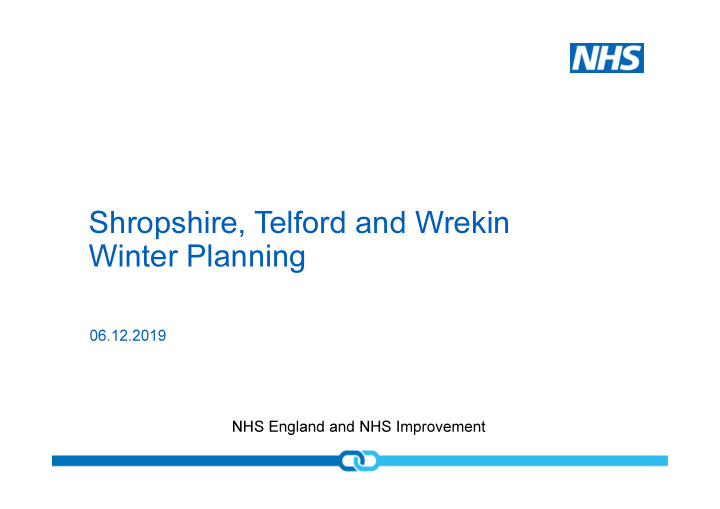



Shropshire, Telford and Wrekin Winter Planning 06.12.2019 NHS England and NHS Improvement
Progress so far • Regional winter conference 12 th of September • Regional template submitted on the 17 th of October • Plan remains iterative based on our dynamic bed modelling which is now updated on a monthly basis according to actual activity rather than historical activity. • A&E Delivery Board requested further information from the A&E Delivery Group on proposed schemes in September and recommended that the full winter plan is submitted to all boards in November after approval at the October A&E Delivery Board. All organisation and commissioning Boards have approved the winter plan. • Only schemes that have a high and medium confidence of being delivered have been recommended for approval. • At present there is a bed gap of minus 4 beds for December. The unexpected delay in the Ward 35 scheme is a major contributor to this gap which will be mitigated by the use of DSU beds at both sites. Schemes to be implemented going forward from November will deliver a near balanced demand and capacity plan, however it must be noted that if a surge in demand occurs, the system escalation plan is triggered including the use of the full capacity protocol. 2 2 | | Presentation title
Challenges • Whilst workforce remains a challenge, all approved scheme owners have assured the A&E Delivery Group of their ability to staff the approved schemes • Engagement of the West Midlands Ambulance Service in winter planning and the process of redesign has been a challenge. This has been escalated to NHSI/E, and a summit led by the A&E Delivery Board Chair has been arranged. • Given the sustained challenges due to the rise in demand and the age and acuity of patients admitted during November and the first week of December, NHSI/NHSE have allocated further funding to the system and further capacity has been purchased out of hospital and in hospital and is represented in the demand and capacity numbers in this presentation. • Powys have been experiencing an acute lack of domiciliary care provision and nursing and residential home provision. They have plans to enhance the provision but this will not bring extra capacity into the system until next year. Because of this, NHSI/E have allocated funds to place Powys patients in Shropshire/Powys border provision, and Shropshire Local Authority have been supporting Powys with the transformation of their services. • Shropshire and Telford and Wrekin Local Authorities are amongst the best in the country at placing patients who are medically fit for transfer within 48 hours of referral. This, coupled with our reduction in the long length of stays in hospital, has made the system an exemplar in the national scheme to reduce long lengths of stay. 3 3 | | Presentation title
Winter Plan 2019/20 – demand and capacity modelling • The development of the winter plan demand and capacity modelling has been overseen by the A&E Delivery Group. • Phase 1 – SATH undertook bed modelling to identify the bed gap between their core bed stock and the predicted winter demand. The table below reflects the position in light of September actual demand. Calculated based on average length of stay and 95% bed occupancy. Sept Oct Nov Dec Jan Feb March PRH -6 -41 -21 -18 -58 -35 -19 RSH -16 -43 -47 -50 -56 -63 -26 SATH Total -22 -84 -68 -68 -114 -98 -45 • Phase 2 – system partners developed a schedule of schemes to create acute bed capacity (or equivalent) in order to bridge the above gap. • A total of 29 schemes comprise the system winter capacity plan covering the 4 categories of: • Additional acute bed capacity • Demand reduction • Internal flow • Complex discharge • 22 of the schemes are assessed as being high confidence of delivery and 7 schemes as being medium confidence. The key risks associated with the medium confidence schemes relate to workforce availability, however, system partners are actively working to ensure that these risks are mitigated
Winter Plan 2019/20 – demand and capacity modelling The summary table shows the acute bed impact for each of the categories of winter capacity schemes. The boxes highlighted in red indicate where a bed gap remains. Winter 2019/20 Sept Oct Nov Dec Jan Feb March PRH RSH PRH RSH PRH RSH PRH RSH PRH RSH PRH RSH PRH RSH SATH Bed Gap By Site (last update Sept 19 actual) -6 -16 -41 -43 -21 -47 -18 -50 -58 -56 -35 -63 -19 -26 Additional acute beds 0 12 0 12 0 12 17 17 18 47 38 47 38 47 Complex discharge 0 0 0 1 2 4 3 6 5 6 5 6 3 6 Acute demand reduction 3 0 3 0 8 5 9 5 12 20 12 20 12 20 Acute flow 0 0 4.5 0.5 6 1 12 6 13 6 14 6 15 6 Total acute bed impact 3 12 7.5 13.5 16 22 41 34 48 79 69 79 68 79 Variance +/- acute bed gap vs mitigating schemes -3 -4 -33.5 -29.5 -5 -25 23 -16 -10 23 34 16 49 53 Use of DSU as Planned Escalation 3 4 16 12 5 12 0 12 10 0 0 0 0 0 Acute bed gap with use of DSU above 0 0 -17.5 -17.5 0 -13 23 -4 0 24 32 17 49 54 Remaining Unplanned Surge Escalation Capacity DSU 13 8 0 0 11 0 16 0 6 12 16 12 16 12
Next Steps • The demand and capacity modelling is reviewed by the A&E Delivery Group and Board on a fortnightly basis. 6 6 | | Presentation title
Recommend
More recommend